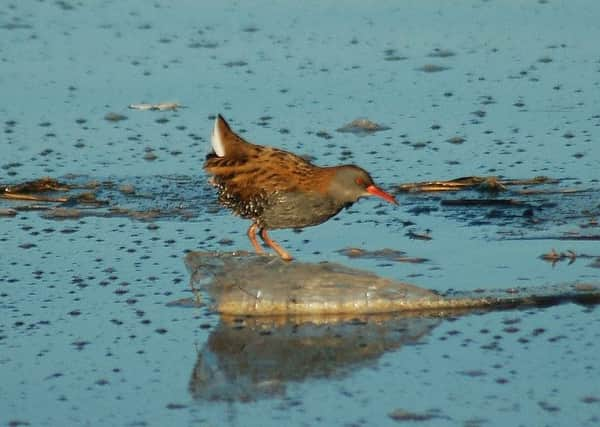Birdwatch: Predatory squealer at large in number


But in winter, especially when the weather turns colder and water freezes, water rails come out into the open more often in search of food.
They are unmistakable with their long sharp red beaks, blue-grey flanks and streaky orange- brown back. Otherwise they are more often heard than seen and the description ‘squealing like a stuck pig’ is a good description of their calls which also includes grunts, wheezes and groans. This is known as ‘sharming’ from the old Norfolk name for the water rail - ‘sharmer’
Advertisement
Hide AdAdvertisement
Hide AdThe calls are used both in spring for courtship and in winter during often fierce battles over territories. Water rails are the most predatory member of the rail family and will hunt other birds, pouncing on them and spearing them with that sharp beak and they also seize and drown their prey.
Bird ringers working in reed beds have to be especially on guard because water rails will readily take a ready caught meal from the nets.
The latest estimate is that there are about 1,000 breeding pairs of water rails in this country but there are probably many more. Birdwatchers in Scotland have been playing recording of their calls next to reed beds and have been surprised by the response.
Numbers are also boosted in autumn by continental arrivals. Water rails are not often seen in flight and when they are look ungainly, fluttering on short rounded wings and with legs trailing low over the reeds.
Advertisement
Hide AdAdvertisement
Hide AdDespite looking unlikely long-distance migrants, an unknown number of water rails arrive here each autumn from central and north west Europe and can sometimes turn up in city centres or on the deck of cross Channel ferries.
Another bird that’s arrived in small numbers is the water pipit which comes here from its breeding sites next to mountain steams in central Europe, one of the few birds that moves north rather than south for the winter. They have been reported at Swillington Ings, Leeds and Adwick Washlands, South Yorkshire.
The juvenile pallid harrier has continued to be seen at Welwick Saltmarsh reserve, East Yorkshire while a hen harrier is coming in to roost at Blacktoft Sands.
A great northern diver and black-necked grebe have continued to be seen at Scarborough Harbour while a black-necked grebe was at Tophill Low and Slavonian grebe at Pugney’s Country Park where a long-tailed duck continues to be seen.
Advertisement
Hide AdAdvertisement
Hide AdAnother long-tailed duck is on Hornsea Mere and a Slavonian grebe at Nosterfield Quarry, North Yorkshire.
A Siberian chiffchaff has been reported this week at Darfield, South Yorkshire.
Snow buntings have been seen along the coast with 15 at Flamborough Head. Inland, others have been reported near the summit of Ingleborough.
Flocks of bramblings have also been reported with at least 80 at Ingbirchworth reservoir, South Yorkshire, while roaming flocks of waxwings have been reported across the region.